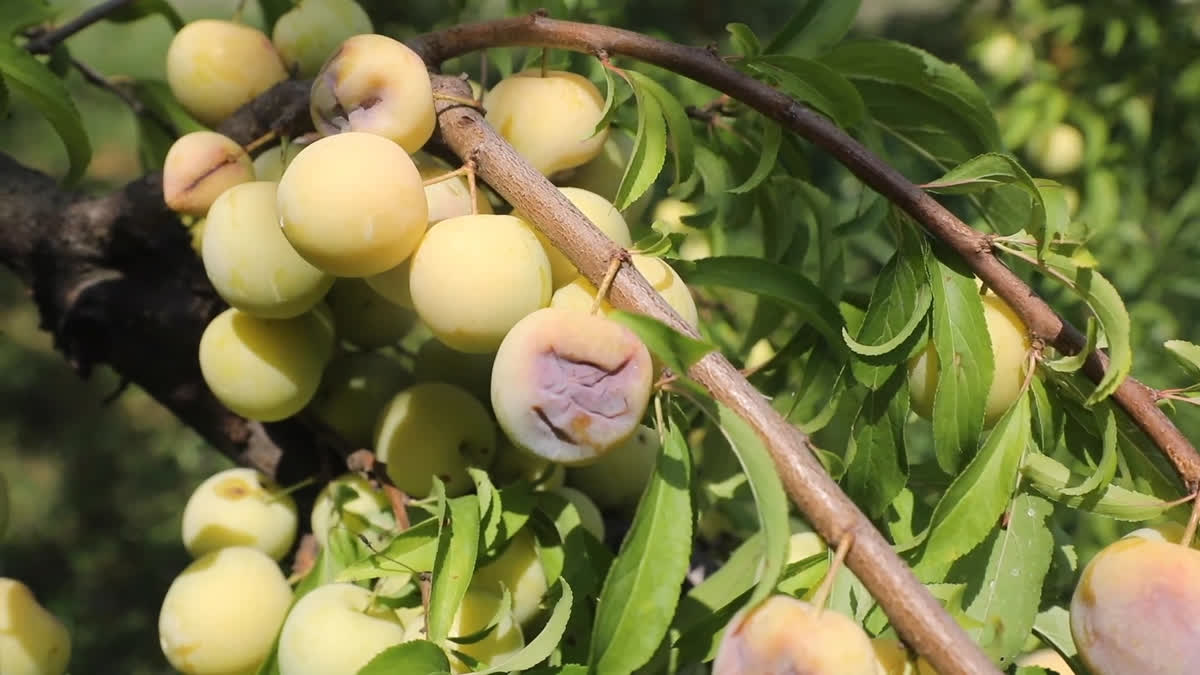Srinagar (J&K): Apart from apples, saffron and dry fruit, plum is another nature's bounty that the fertile plains of Kashmir offer but incessant rains this year have washed away farmers' hopes of a good produce.
From the middle of July to the end of August is the plum season as farmers begin harvesting the fruit. They mutter a prayer or two for, one, good quality fruit and, two, a better price when it reaches the market. Rains, however, have spoiled such prospects this year as farmers rue poor plum output, much like strawberries and cherries were affected earlier this year.
Ghulam Rasool, a 65-year-old plum and apple grower, claims that despite his best efforts, this year's harvest was not as good as previous years. "In the past, our orchard sold thousands of boxes of plums every day, but this year, just a small number had been sold," he told ETV Bharat as he sat in the orchard packing the measly produce. "The fruit is either damaged or has scars from the rain, therefore the pricing is not favourable," said Ghulam as he cupped a handful of plums, sheen off of most of them.
On the outskirts of Srinagar, Ghulam used to grow apples in his orchards, but he later chose plums because they were easier to care for and more profitable. Compared to apples, plums, Ghulam says, require less maintenance. "The medication just has to be sprayed once. As a result, both the cultivation and the income were excellent. The harvest was modest the previous year and we were expecting better produce this year but rains spoiled everything," he said.
Also read: Pulwama, purple paradise of Kashmir: Lavender cultivation increases in two years
A 5kg box of plums is sold for Rs 200 to Rs 250, while a 2kg box fetches Rs 100 to Rs 120 in the wholesale market, according to Ghulam. Though rains made it difficult for fruit growers this year, Kashmir farmers and the land have generally taken well to plums.
According to the J&K Department of Horticulture, Kashmir produced this fruit on average in the last three seasons at a rate of around 8,000 tonnes per season on around 1500 hectares of land used for its cultivation. The majority of plum orchards are located in central Kashmir's Budgam district. Most recent statistics of the horticulture department show that Jammu produces 4,150 tonnes of plums whereas Kashmir Valley produces 7,710 tonnes. Budgam generates 2,719 tonnes of the 11,860 tonnes of total production, the most by any district, followed by Ganderbal.
Centros plum is one of the three principal types farmed in Kashmir, according to the department. It has historically been a significant source of revenue for the valley's plum producers. In numerous other regions of the valley, in the direction of Srinagar, this "sweet and sour" fruit is produced. Only on a modest scale are the other two types, silver plum and chugandhara, produced.
President of Fruit Market, Parimpora, Basheer Ahmad Basheer, told ETV Bharat over the phone that the output this year is quite low. "The unfavourable weather this year has had an impact on production everywhere. We have not yet evaluated the overall damages," he said.
"Plums from the Parimpora market are mostly transported directly to Delhi and Punjab marketplaces, where they are then shipped and sold in other markets of the country. Plum is a fragile fruit. It has a relatively short shelf life. Farmers pick the fruit in mid-July when it is half-ripe to increase its shelf life," he said.
Also read: Young American starts apple chips plant in Kashmir; follows 'tsounthachi' tradition



